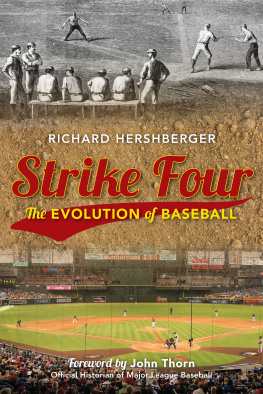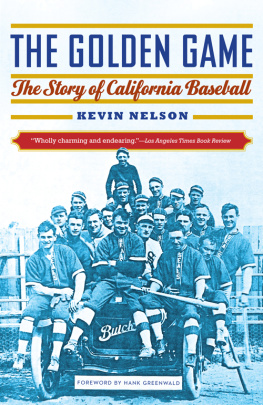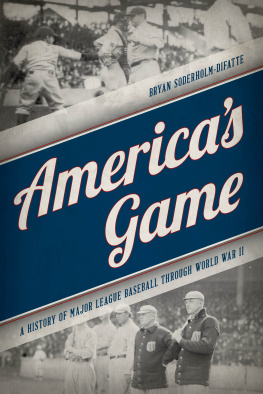A HISTORY OF BASEBALL IN 100 OBJECTS
A Tour through the Bats, Balls, Uniforms, Awards, Documents, and Other Artifacts that Tell the Story of the National Pastime

JOSH LEVENTHAL

Copyright 2015 Josh Leventhal
All rights reserved. No part of this book, either text or illustration, may be used or reproduced in any form without prior written permission from the publisher.
Published by
Black Dog & Leventhal Publishers, Inc.
151 West 19th Street
New York, NY 10011
Distributed by
Workman Publishing Company
225 Varick Street
New York, NY 10014
Cover design by Elizabeth Driesbach
eISBN-13: 978-1-60376-401-8
ISBN-13: 978-1-57912-991-0
Library of Congress Cataloging-in-Publication Data available on request.
Contents
Introduction
Baseball has a long and storied history, its evolution affected by pioneering executives and managers, legendary players, milestone moments, and changes to the rules of this tradition-loving pastime. While many of the sports basic tenets have held strong for more than 150 years, each new era has seen signature developments that have altered the very experience that is baseball.
This book traces that evolution by examining the objects that represent game-changing moments and individuals from the sports history. While equipment and objects, from bats to balls to uniforms, are very much central to baseball and have been transformed in many ways through the years, this book is not a history of those objects. Rather it is an exploration of the game of baseball as told through the equipment, documents, and other artifacts that illustrate its key eras and events.
We encounter a wide range of objectsfrom the well-known to the obscure, from equipment used on the field of play to documents penned in corporate offices, from rewards of triumph to symbols of disgrace. Each has its own story to tell and each one takes us further along the chronological unfolding of the sports history.
The journey begins, perhaps surprisingly, in medieval Europe, centuries before Abner Doubleday, Alexander Cartwright, Henry Chadwick, Albert Spalding, or any of the other so-called fathers of baseball walked the diamond. A document from early fourteenth-century Flanders shows us that bat-and-ball games, baseballs distant ancestors, have been part of childhood recreation since long before words like runs batted in or even innings entered the vocabulary.
Leaping ahead nearly half a millennium, to the very earliest years of nationhood for the United States, another document, this one from late-eighteenth-century Massachusetts, reveals the first known appearance of the term baseball on these shores. By this time, the game was commonplace enough as to elicit town bylaws to limit when and where it could be played.
The next object on the path through baseballs history represents the role that legend plays in the national pastime. A ball believed (dubiously) to have been used by one Abner Doubleday in Cooperstown, New York, in 1839, helped to fuel the mythology of Doubleday as the games inventor. Although the story was widely disputed from the moment it was presented in the early twentieth century, Doubledays place in the baseball pantheon was cemented with this rendition of baseballs origin story.
The codified rules compiled by the Knickerbocker Base Ball Club in 1845 provide a firm foundation from which the sport evolved over the next 170 years. While some of the principles laid out in this document have long since been dropped from the rule book, the basic procedures and guidelines will be very familiar to baseball fans of subsequent generations up through today.
From there we find key documents establishing organized leagues and further defining the rules of play. A game ball from the first contest played within an enclosed ballpark, where tickets could be sold, takes us on a first step on the inevitable path toward baseball as commercial business.
Professionalism in the game was first introduced by the Cincinnati Red Stockings, whose 1869 game ball represents the dawning of the new era. The flip side of that era is seen with a political cartoon from the 1880s depicting baseball players as chattel to be auctioned off to the highest bidder. The ongoing battle between owners and players finds its roots in the earliest days of the sport.
Baseballs maturation was not just about economics; it was also about developing new equipment, such as gloves for fielders and masks for catchers. The continuing expansion of organized league play brought a need to honor championship teams. The Worlds Series trophy of 1888 and the Temple Cup of 1897 tell the story of the precursors to our modern World Series.
With the turn of the twentieth century came new leagues, new dynasties, and new stars. Awards given to Cy Young and Ty Cobb show the dominance of those players during the Dead-Ball Era, while Joe Jacksons shoes take us back to one of baseballs more shameful moments. Off the diamond, we experience the birth of new traditions with the original lyrics to Take Me Out to the Ball Game, a bucket used to sell hot dogs at the ballpark, and the first ball pitched by a U.S. president at a major league game. Honus Wagners tobacco card of 1909today worth millions of dollarsexemplifies the phenomenon of baseball-card collecting through the decades.
The agreement that sent Babe Ruth from the Boston Red Sox to the New York Yankees in 1919, and the mighty Ruths home run crown of 1921, bring us to the birth of the lively ball era and the emergence of the long ball as baseballs ultimate thrill. Technological advances, from radio and television broadcasts to lights illuminating ballparks for night baseball, further hastened the explosion in baseballs popularity in the years between the two world wars.
Objects representing the remarkable 1941 seasons of Ted Williams and Joe DiMaggio introduce a new generation of stars, and a War Department identification card belonging to Hank Greenberg reminds us of the impact that World War II had on the American pastime, not to mention the nation as a whole. The postwar years, in turn, brought baseballs ultimate progressive action, when Jackie Robinson first donned a Brooklyn Dodgers uniform in 1947. Two of the most dramatic on-field moments are on display with a ticket stub to the 1951 Giants-Dodgers playoff game and the glove used by Willie Mays to make one of the most memorable catches of all time.
In the following decade, a historic home run ball hit by Roger Maris and a Cy Young Award belonging to Sandy Koufax join the continuous narrative of heroic achievements on the field. And, once again, decisions made in owners and commissioners officesfrom teams relocating across the country and new franchises coming into existence, to changes in the physical appearance of the playing field and the creation of a new positionillustrate the continuing evolution of how, where, and by whom the game is played.
The bat that Roberto Clemente used to reach the 3,000-hit milestone is about more than the accomplishment of one individual. It is a symbol of the changing face of baseball and a new generation of stars emerging from foreign lands and thriving at the major league level. The floodgates to a new economic structure were opened, as well, when Catfish Hunter used a 39-cent ballpoint pen to ink a contract worth more than $3 million. Big stars would earn big bucks, and oneReggie Jacksonwould even get a candy bar named after him.
Next page









